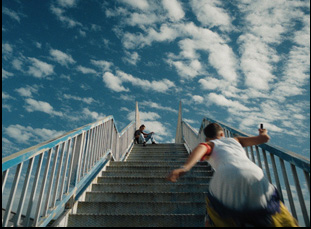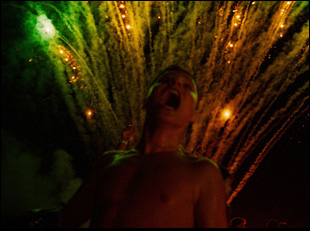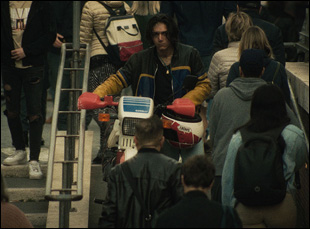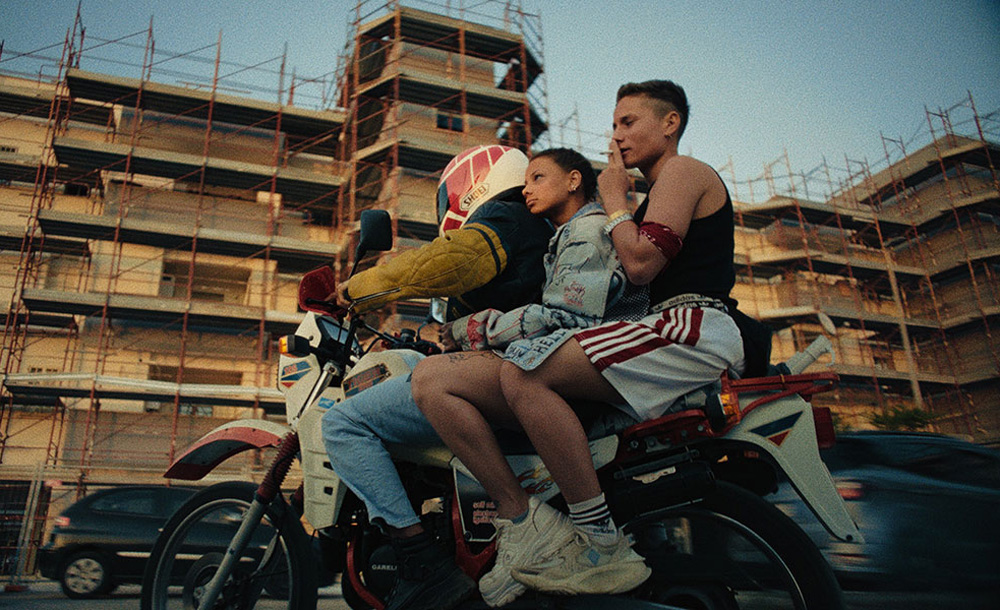“We’re no longer kids, are we?” Alex (Enrico Bassetti) says on the occasion of his 19th birthday in “An Endless Sunday.” There’s some debate between him and his friend Kevin (Zackary Delmas), who’s three years younger, about whether he’s entered his twenties when in spite of not reaching twenty quite yet, any time spent over 19 is part of a new decade, and the two and Alex’s girlfriend Brenda (Federica Valentini) may get caught up in conversation about what precise age their celebrating, but not let it get in the way of the festivities themselves as they hit up a carnival and go joyriding around town in their neck of Italy.
“An Endless Sunday” starts out on a tilt-a-whirl and writer/director Alain Parroni never lets you off as the trio takes different tacts to spending their idle time, each quite possibly portending the adults they’re set to become. While Alex begins work at an urban farm to start making a little scratch, Kevin gets busy actually etching his name into any public space he can find to leave his mark on, believing it’s a much more obvious way of owning his future. Not tied down to any particular place, Kevin can also spend a lot more time with Brenda, who is more ambivalent about her future, though it may be coming sooner than she thinks after she realizes her period’s late. The trio is capable of throwing one another for a loop, but the situation they’re in seems likely to spin out of control on its own as life takes them in different directions and they try to hold onto each other when they’ve been friends for so long, it’s hard to imagine a future otherwise.
It’s telling that Kevin will light cigarettes with a propane tank when a typical lighter is out of reach when Parroni imagines this turning point for the trio as such a combustible moment in time, where having fun and rebelling against their seemingly inevitable fate appear one and the same, and there’s a propulsive energy throughout “An Endless Sunday,” which suggests in its title a carefree chronicle of adolescence, but is anything but when it teens with anxiety about the day after next. However, the filmmaker shows true nerve only in a good way in his fierce feature debut, thrusting audiences into an experience informed by different eras of cinema but feeling entirely fresh as Alex, Kevin and Brenda’s constant chase after a good time spills into the film. No wonder then it was celebrated at both the Venice and Toronto Film Festivals this past week and with the help of a translator, we caught up with the director who spoke of how he was able to infuse his personal history into the film while making a universal coming-of-age story, letting his cast literally and figuratively take the wheel at times and creating such an explosive drama.

The original idea was the three characters and the situations in which they move. There are many elements in the film that lead to other situations that we have removed, so the atmosphere and the characters remained the same and it was a question of finding actions that had no consequences and all these actions compress, compress, compress until they explode with Alex’s actions in the end.
Once you had your cast, did it change your ideas about the story or the group dynamic?
Actually, no. Even if it all seems very natural, it’s all very much what we had written. It was like a roller coaster, but we relied on the strength of the [cast] and sometimes I was the one giving the directions to the guys, pulling them towards me while I was driving the car, and sometimes I let them do their thing and I was the one following them. So [there wasn’t anything] that informed how the actors were interacting. But for instance, maybe where there was a bit of a lull, like the 15th of August segment, I would try and physically pull them to do into doing things. There were other times though where they would just take the lead and roll with it and I’d just follow what they did.

Yes, all the places in the film are places that have meant a lot to my adolescence. The city was a place where you could go as if you were going to a an amusement park, and opening the subway doors [and filming] in the countryside or in the low-income housing area, or shooting the party on the 15th of August, which has a real significance civically for Italians, everything gives a little piece that allows for a feeling of anguish for a teenager who doesn’t know how to emerge [from it]. The city of Rome does this more than any other city, because when you go there, you have to deal with the history that was there before. When you see a monument, you know that there were people who left their mark. The city gives you that anxiety and makes you realize that you have to find a meaning in your life.
It seems like not only the locations have a personal resonance, but you have these wonderful photo montages that seem like you might’ve snuck a few family pictures in. How did those make it into the film?
Photography always belongs to the dimension of the past. When we see a movie, it’s happening in front of our eyes. What we see seems to be the present, because it’s in motion, so the idea of using photographic sequences was to make a little account of the past and I’m always trying to reflect on the path we will leave. Even when I use the photographs, it was to make it look like a film that came from the past that projected itself to the future because I think that every film is a film about time travel where we are projected in the future even though we’re not there yet.

Every scene had its peculiarities and its quirks, but the rave was perhaps the one where I felt like I was almost hallucinating because I had a very high fever that day. While I was shooting, it almost felt like I was living the rave myself. But as with all the other moments, my upbringing in cinema is full of influences and I didn’t grow up with just one film, so my gaze is constantly contaminated by all the films I’ve seen and even in the mise-en-scene, we tried to have a variety.
I feel that’s reflected as early as the opening credits, which is one of the most arresting introductions I’ve seen as far as grabbing your attention and acknowledging all the global influences when the credits are in different languages. What was it like to come up with?
Initially, we built it as a classic and epic film [using the font] of classic Italian films, but also very big and in blue because Shiro’s score was very suited to that. But then immediately after, we printed it on film and we decided to scratch all around the names and ruin the opening credits to look a little bit [like graffiti] just because it could be that the new generation has a tendency to vandalize what was left previously by their predecessors, and it was like [setting up] the premise that it’s an epic film but it belongs to a generation that maybe could not respect all the language that was there before. The sky is also an important element in the film, it’s always present, looking down, so it’s descriptive of what will happen, and the film is always shot from bottom to top, so it was almost a way of bringing everybody up to the sky by using blue.
Between your premiere in Venice and arriving in Toronto with your first feature, what have these last few days been like for you?
The feeling is like being stunned because it’s a bit embarrassing that just until a few weeks ago we were at home just sitting around, with my producer Giorgio and a few of my fellow [crew] working on this homemade film one day, just at home talking on small things in the film, to the next [where] thousands of people have already seen it in different areas of the world. So it’s a very, very strange feeling, but I’m very proud because the [cinematic] language is a very different style from an ordinary type of movie, and the fact that it has been recognized in Venice and now it’s here in Toronto, two different festivals with different kind of audiences, shows that it speaks to many different cultures.
“An Endless Sunday” does not yet have U.S. distribution.




